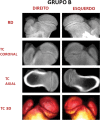Animal Model Standardization for Studying Avascular Necrosis of the Femoral Head in Legg-Calvé-Perthes Disease
- PMID: 37908528
- PMCID: PMC10615593
- DOI: 10.1055/s-0042-1749418
Animal Model Standardization for Studying Avascular Necrosis of the Femoral Head in Legg-Calvé-Perthes Disease
Abstract
Objective Testing an experimental model for ischemic necrosis of the femoral head in Legg-Calvé-Perthes disease by evaluating gait, imaging and morphohistology. Methods The operation was done in 11 piglets. Necrosis by cerclage in the right femoral neck was induced. Piglets were divided into group A, with 8 animals, euthanizing two in the 2 nd , 4 th , 6 th , and 8 th weeks, respectively; and group B, with 2 animals ( sham ), submitted to the surgical procedure without cerclage of the right femoral neck. The gait classification used was that of Etterlin. The frozen femurs were submitted to digital radiography and computed tomography. The height and width of the epiphysis and epiphysary coefficient were measured at study times. Light microscopy and immunohistochemistry with TGF-β1 were performed. Results One animal died of sepsis in Group A. In this group, claudication was observed in all animals. On digital radiography and computed tomography, bone sclerosis, enlargement of the right femoral neck, flattening, collapse, and fragmentation of the right femoral head were observed. All epiphysis height and epiphysary coefficient values of the right femoral head were lower than the contralateral ones, in which were observed chondrocytes disordered and separated by gaps. A reduction in TGF-β1 expression was observed at 2 and 6 weeks in the right femoral head and at eight in the left. In group B, there were no signs of necrosis and gait was normal. Conclusions The model presented reproduced macroscopic necrosis on digital radiography, computed tomography, and microscopy. Gait evaluation showed a good correlation with other ischemia findings. Level of Evidence V. Diagnostic studies.
Keywords: Legg-Calvé-Perthes disease; femur head necrosis; ischemia; models, animal.
Sociedade Brasileira de Ortopedia e Traumatologia. This is an open access article published by Thieme under the terms of the Creative Commons Attribution-NonDerivative-NonCommercial License, permitting copying and reproduction so long as the original work is given appropriate credit. Contents may not be used for commecial purposes, or adapted, remixed, transformed or built upon. ( https://creativecommons.org/licenses/by-nc-nd/4.0/ ).
Conflict of interest statement
Conflito de Interesses Os autores declaram não haver conflito de interesses.
Figures




















Similar articles
-
Evaluation of femoral head viability via bone scintigraphy in the postoperative pediatric patient.Pediatr Radiol. 2018 Mar;48(3):350-358. doi: 10.1007/s00247-017-4030-7. Epub 2017 Nov 27. Pediatr Radiol. 2018. PMID: 29181581
-
Pathogenesis of metaphyseal radiolucent changes following ischemic necrosis of the capital femoral epiphysis in immature pigs. A preliminary report.J Bone Joint Surg Am. 2004 Jan;86(1):129-35. doi: 10.2106/00004623-200401000-00019. J Bone Joint Surg Am. 2004. PMID: 14711955
-
Age at onset-dependent presentations of premature hip osteoarthritis, avascular necrosis of the femoral head, or Legg-Calvé-Perthes disease in a single family, consequent upon a p.Gly1170Ser mutation of COL2A1.Arthritis Rheum. 2008 Jun;58(6):1701-6. doi: 10.1002/art.23491. Arthritis Rheum. 2008. PMID: 18512791
-
[Legg-Calvé-Perthes disease].Tidsskr Nor Laegeforen. 2011 May 20;131(9-10):946-9. doi: 10.4045/tidsskr.10.0456. Tidsskr Nor Laegeforen. 2011. PMID: 21606991 Review. Norwegian.
-
Can large doses of glucocorticoids lead to Perthes? a case report and review of the literature.BMC Pediatr. 2021 Aug 12;21(1):339. doi: 10.1186/s12887-021-02755-4. BMC Pediatr. 2021. PMID: 34384372 Free PMC article. Review.
Cited by
-
Targeted transarterial embolization of the femoral head: development of a minimally invasive approach to model Legg-Calvé-Perthes disease in piglets.PLoS One. 2025 May 14;20(5):e0323360. doi: 10.1371/journal.pone.0323360. eCollection 2025. PLoS One. 2025. PMID: 40367088 Free PMC article.
-
Progress in understanding Legg-Calvé-Perthes disease etiology from a molecular and cellular biology perspective.Front Physiol. 2025 Feb 17;16:1514302. doi: 10.3389/fphys.2025.1514302. eCollection 2025. Front Physiol. 2025. PMID: 40041162 Free PMC article. Review.
References
-
- Koob T J, Pringle D, Gedbaw E, Meredith J, Berrios R, Kim H KW. Biomechanical properties of bone and cartilage in growing femoral head following ischemic osteonecrosis. J Orthop Res. 2007;25(06):750–757. - PubMed
-
- Boss J H, Misselevich I. Osteonecrosis of the femoral head of laboratory animals: the lessons learned from a comparative study of osteonecrosis in man and experimental animals. Vet Pathol. 2003;40(04):345–354. - PubMed
-
- Komiyama T, Nishida K, Yorimitsu M et al.Decreased levels of insulin-like growth factor-1 and vascular endothelial growth factor relevant to the ossification disturbance in femoral heads spontaneous hypertensive rats. Acta Med Okayama. 2006;60(03):141–148. - PubMed
LinkOut - more resources
Full Text Sources

